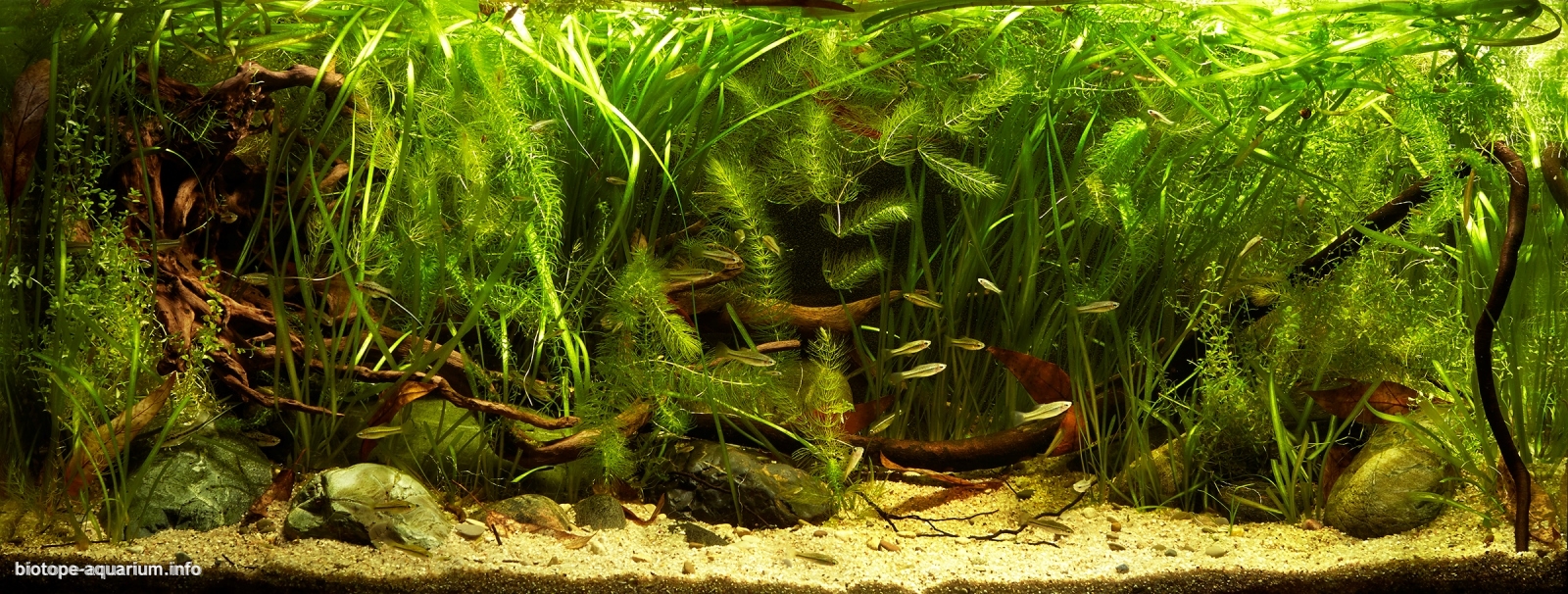The coastal area of the Moctezuma river, above the town of Tamazunchale, state of San Luis Potosi, Mexico
_th place in Biotope Aquarium Design Contest 2020

Volume: 156 L
Dimensions: 100x39x40 cm
List of fishes: Xiphophorus montezumae
List of plants: Vallisneria spiralis, Ceratophyllum sp., Elodea sp., Micranthemum umbrosum
Description of decorations: Natural large dark gray stones, similar in shape and color to the stony rock along the banks of the Moctezuma river; natural light sand, similar to the soil at the bottom of the river; natural large dark snags.
Description of equipment: external filter JBL CristalProfi greenline e901, lamp Solarcolor T5 45 w, Solarnatur T5 45w, heater Tetratec NT 100, 100 w
Water parameters: pH 7.2, dH 14°; the temperature is 24°C
Additional info: Regular water change (30% every 3 weeks), fish feeding is done every other day with live, frozen or dry food
INFORMATION ABOUT BIOTOPE:
Description of the area surrounding the biotope: The Moctezuma river begins in Hidalgo state at the Zimapan dam, at the confluence of the Tula river and the San Juan river. From the Tula river, it receives the waters of the drainage rivers of the valley of Mexico. The Moctezuma river then flows through the state of San Luis Potosi.
The state of San Luis Potosi is located in the Northern center of the country, in the Central part of the Mexican plateau, except in the South-Eastern part of the state – it lies on a plateau of the river Panuco. The surface of the plateau is relatively flat, with a few low wooded mountains. From North to South, the Eastern Sierra Madre range runs through the state, which separates the Mexican Plateau from the plain at the Gulf of Mexico. The Eastern part of the state is the coastal plain.
The average height above sea level is about 1800 m. There are no major rivers. The state’s largest river is the Panuco. The territory of the state of San Luis Potosi is classified as a tropical savanna. The area around the city of Tamasunchale is arid, with rare shrubs and cacti, the height above sea level is 307 meters.
Along the banks of the Moctezuma river there are thickets of reeds, sedge and other similar plants.
Description of the underwater landscape of the biotope: The river bottom is partly sandy, partly rocky, and sometimes muddy. There are rocks and driftwood in the underwater landscape. The stones are large, dark gray, and the sand is light. The water is clear, along the banks there are moisture-loving plants such as reeds, sedges, shrubs.
Description of the parameters of the habitat: Most of the state of San Luis Potosi is dominated by arid and semi-arid conditions. Average temperatures range around +18 °C. In may, the temperature can reach +30 °C, and in January +3 °C. Average precipitation is about 800 mm / year.
The Moctezuma river is shallow, with clear water. Throughout tropical Southeastern Mexico, there is a high rate of precipitation, which leads to infertility of reddish or yellow laterite soils with a high content of iron oxides and aluminum hydroxides. Deep, easily crumbling, and rich in basic minerals, some of these dark soils have been cultivated continuously for centuries. However, constant cultivation of the land has exposed hard lime in many areas. Accordingly, the water in the river is calcareous and has a high overall hardness.
List of fishes and invertebrates occurring in the nature biotope: Xiphophorus montezumae, Xiphophorus sp., Xiphophorus pygmaeus, Xiphophorus helleri, Ameca splendens
List of plants found in the nature biotope: Vallisneria spiralis, Eleocharis cellulosa, Hydrocotile verticillata, Ludwigia peploides, Cyperus alternifolius, Alocasia macrorrhiza, Ceratophyllum demersum, Fissidens fontanus, Eichhornia crassipes, Spirogyra sp., Sagittaria macrophylla, Hydrocotyle ranunculoides, Egeria densa, Nymphaea mexicana, Ludwigia peploides, Leersia hexandra, Eichhornia crassipes, Berula erecta, Bacopa monnieri, Typha domingensis, Nymphaea gracilis, Pistia stratiotes
Threats to the ecology:
Sources of information:
Description of the Montezuma swordfish species: http://aquafisher.org.ua/zhivorodyashhie/rod-xiphophorus-mechenostsyi-2/
The appearance of the biotope: https://www.facebook.com/Río-Moctezuma-1997183687210045/
https://www.fishbase.de/summary/Xiphophorus-montezumae.html
The river Moctezuma: https://es.wikipedia.org/wiki/Río_Moctezuma
https://mapcarta.com/19997244
https://www.youtube.com/channel/UCurIgf34W4zpRob5_1MM-kg
The Nature Of Mexico: https://priroda36.ru/priroda-zemli/556-priroda-mexiki.html?start=3
https://www.britannica.com/place/Mexico
State of Sant Luis Potosi: https://ru.wikipedia.org/wiki/Сан-Луис-Потоси_ (state)
https://megabook.ru/media/San Luis Potosi%20(map)
https://www.tes.com/lessons/NCYEuvrrhQ6-5A/heritage-project
https://www.britannica.com/place/Sierra-Madre-mountain-system-Mexico/Physiography
Soil map of Mexico: https://uk.maps-mexico-mx.com/Мексика-природні-ресурси
Montezuma’s swordfish in the biotope aquarium https://www.youtube.com/watch?time_continue=69&v=79moPzKp8P4&feature=emb_logo
The biodiversity of the river basin of Moctezuma river: https://www.gbif.org/es/dataset/88e450ba-2076-4947-9529-9d0cfbb06f2a#description
Tamazunchale: https://web.archive.org/web/20110517231203/http://www.e-local.gob.mx/work/templates/enciclo/sanluispotosi/municipios/24037a.htm
